So where am I really blogging?
...over at Abby's Yarns!
I just keep this account around so I can comment on all the blogger folks' blogs!
I just keep this account around so I can comment on all the blogger folks' blogs!
That's just my mom -- don't talk to her unless you like boring yarn and stuff.
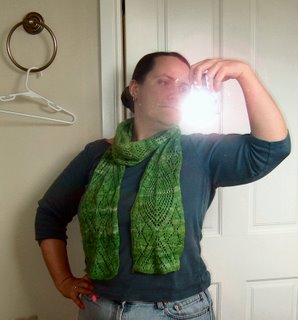
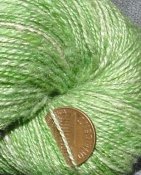 The Strauch fine carders, with the brush, just do an incredible job on blending things like that. I've since done lots and lots of merino/tussah/cashmere blends, and they're so much fun to spin! One interesting thing that this particular yarn really helps me to illustrate is the point I'm forever harping on, that yarn should be designed to have the qualities one wants in the finished product, rather than in the skein or on the bobbin or spindle -- and by "finished product," I mean it's been washed, blocked, and maybe even is actually in use.
The Strauch fine carders, with the brush, just do an incredible job on blending things like that. I've since done lots and lots of merino/tussah/cashmere blends, and they're so much fun to spin! One interesting thing that this particular yarn really helps me to illustrate is the point I'm forever harping on, that yarn should be designed to have the qualities one wants in the finished product, rather than in the skein or on the bobbin or spindle -- and by "finished product," I mean it's been washed, blocked, and maybe even is actually in use.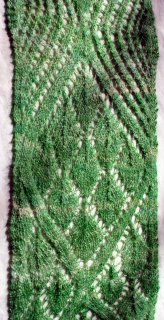 This yarn has significantly more twist in it than is typical for commercial yarns in this thickness (I knit the scarf on US size 2 needles, which were the biggest I could get away with). In the skein, though it had been washed and hung unweighted to dry, it had a stiffer hand than most lace knitting yarns, and was very smooth-surfaced with essentially no fuzz.
This yarn has significantly more twist in it than is typical for commercial yarns in this thickness (I knit the scarf on US size 2 needles, which were the biggest I could get away with). In the skein, though it had been washed and hung unweighted to dry, it had a stiffer hand than most lace knitting yarns, and was very smooth-surfaced with essentially no fuzz. Without further ado, let me introduce this selection of yarn photos! At left we have a novelty yarn that I like in spite of myself, and am liable to actually produce again and do something with. The darker brown is adult camel top, and the pale tan colour is natural tussah silk. I spun this some time ago, picking up a bit of one fiber and spinning it, and then switching to the other. When I had two bobbins reasonably full enough, I plied them together, resulting in the skein at left. What you see on the right is one partial bobbin.
Without further ado, let me introduce this selection of yarn photos! At left we have a novelty yarn that I like in spite of myself, and am liable to actually produce again and do something with. The darker brown is adult camel top, and the pale tan colour is natural tussah silk. I spun this some time ago, picking up a bit of one fiber and spinning it, and then switching to the other. When I had two bobbins reasonably full enough, I plied them together, resulting in the skein at left. What you see on the right is one partial bobbin. Next up, a 2-ply alpaca yarn spun from commercial top. It's a knitting yarn. I have dithered for some time now as to whether or not I should overdye this, or do something with it in the existing deep gray colour. There's about a sweater's worth. Of course, I'm already well stocked with alpaca sweaters, and I'm really not much of a sweater knitter... so there the yarn sits, in my stash. Mothballed, literally!
Next up, a 2-ply alpaca yarn spun from commercial top. It's a knitting yarn. I have dithered for some time now as to whether or not I should overdye this, or do something with it in the existing deep gray colour. There's about a sweater's worth. Of course, I'm already well stocked with alpaca sweaters, and I'm really not much of a sweater knitter... so there the yarn sits, in my stash. Mothballed, literally!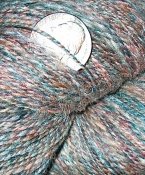 Ah yes, this fella. I named it "Zoot Suit" apparently, but I can't quite recall why. In person and up close, it does have a nifty sheen to it, and a vaguely sharkskin kind of look, so perhaps that's why. I think it was a commercial top -- there's a fine wool, merino most likely, and some nicer mohair, leading me to suspect it must have been that Ashland Bay blend. Honestly, I can't be sure. It's a huge skein, probably around a thousand yards, about 8 ounces. It is destined, perhaps, for a small sweater of some kind. Or socks. It would be a good sock yarn, but there's a lot of it.
Ah yes, this fella. I named it "Zoot Suit" apparently, but I can't quite recall why. In person and up close, it does have a nifty sheen to it, and a vaguely sharkskin kind of look, so perhaps that's why. I think it was a commercial top -- there's a fine wool, merino most likely, and some nicer mohair, leading me to suspect it must have been that Ashland Bay blend. Honestly, I can't be sure. It's a huge skein, probably around a thousand yards, about 8 ounces. It is destined, perhaps, for a small sweater of some kind. Or socks. It would be a good sock yarn, but there's a lot of it.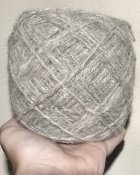 Oh, now this guy I really liked a lot. I designed this yarn specifically for Sandy, using silver alpaca from one of her much-doted-on herd. She was kind enough to give me bags and bags of alpaca, and let me borrow her drum carder when I was trying to decide whether or not I wanted to buy my own, and I felt like she deserved something really nifty made from her own beloved animals... but something she could use herself, to make what she wanted. Although I will admit I suggested a hat. So here we have it: a 3-ply yarn, 70% alpaca and 30% natural coloured tussah silk, a good 5 ounces if memory serves. Soft, shiny, strong, warm.
Oh, now this guy I really liked a lot. I designed this yarn specifically for Sandy, using silver alpaca from one of her much-doted-on herd. She was kind enough to give me bags and bags of alpaca, and let me borrow her drum carder when I was trying to decide whether or not I wanted to buy my own, and I felt like she deserved something really nifty made from her own beloved animals... but something she could use herself, to make what she wanted. Although I will admit I suggested a hat. So here we have it: a 3-ply yarn, 70% alpaca and 30% natural coloured tussah silk, a good 5 ounces if memory serves. Soft, shiny, strong, warm.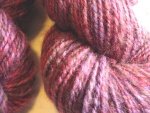 And last up for this entry, we have a 2-ply alpaca/coopworth blend that I spun up from a roving I bought on eBay, from Jehovah Jireh Farm, where they do some great colour work. Even though I loathe pink, and this has pink in it, I have to admit that I like it. It's a bit scratchy, so it's a likely sweater. You know, because I knit so many sweaters! Okay, so it's a stash queen. Like a garage queen, except... in my stash.
And last up for this entry, we have a 2-ply alpaca/coopworth blend that I spun up from a roving I bought on eBay, from Jehovah Jireh Farm, where they do some great colour work. Even though I loathe pink, and this has pink in it, I have to admit that I like it. It's a bit scratchy, so it's a likely sweater. You know, because I knit so many sweaters! Okay, so it's a stash queen. Like a garage queen, except... in my stash.

 Anyway, I knit the falling leaves section for rather a while, and then I had to pack up this project (along with everything else) when November and December saw us unexpectedly moving. Once moved, though, it came out almost immediately, and I finished the falling leaves section.
Anyway, I knit the falling leaves section for rather a while, and then I had to pack up this project (along with everything else) when November and December saw us unexpectedly moving. Once moved, though, it came out almost immediately, and I finished the falling leaves section.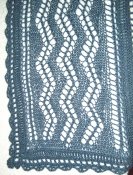 I felt that it needed more than that, however. I had plenty of the yarn, having bought a pile of it when it first came out -- when I know I like a yarn, it's not unusual for me to buy what should be a sweater's worth, specifically so that I have lots of flexibility to make almost anything from it. Anyway, so I decided to throw together some zig-zag end pieces to add a little interest to the shawl.
I felt that it needed more than that, however. I had plenty of the yarn, having bought a pile of it when it first came out -- when I know I like a yarn, it's not unusual for me to buy what should be a sweater's worth, specifically so that I have lots of flexibility to make almost anything from it. Anyway, so I decided to throw together some zig-zag end pieces to add a little interest to the shawl. Okay, okay, and fourth: crochet's fast. So, when you're in the finishing stages of a project, you spend less time irritable about how loooooooong it takes to finish. And that lets you move right on to trying to figure out how to block the enormous object! In this case, because the shawl is probably six feet long, I ended up steaming it with an iron, in sections, laid across the ironing board.
Okay, okay, and fourth: crochet's fast. So, when you're in the finishing stages of a project, you spend less time irritable about how loooooooong it takes to finish. And that lets you move right on to trying to figure out how to block the enormous object! In this case, because the shawl is probably six feet long, I ended up steaming it with an iron, in sections, laid across the ironing board.

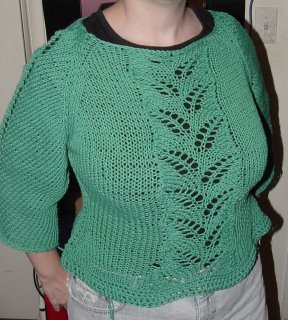 Green Cotton Raglan
Green Cotton Raglan


 Feathery Scarf
Feathery Scarf